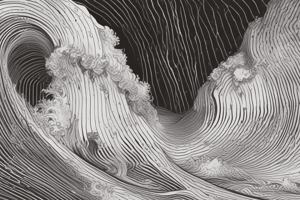Podcast
Questions and Answers
Can sound pass through water?
Can sound pass through water?
- No
- Yes (correct)
A human can hear sounds up to 30 KHz?
A human can hear sounds up to 30 KHz?
- No (correct)
- Yes
Can sound travel through space?
Can sound travel through space?
- No (correct)
- Yes
Do light and sound travel in waves?
Do light and sound travel in waves?
The larger the amplitude of the wave on the trace, the louder the sound. The bigger the wave you can see, the ______ the sound.
The larger the amplitude of the wave on the trace, the louder the sound. The bigger the wave you can see, the ______ the sound.
The loudest sound has the largest amplitude. Amplitude is the distance from the horizontal line to the peak of each curve. The larger the amplitude, the more energy a wave has. Therefore, the loudest sound is represented by the ______ amplitude.
The loudest sound has the largest amplitude. Amplitude is the distance from the horizontal line to the peak of each curve. The larger the amplitude, the more energy a wave has. Therefore, the loudest sound is represented by the ______ amplitude.
Flashcards are hidden until you start studying
Study Notes
Sound and Wave Model
- Sound is defined as vibrations that travel through the air or another medium and can be heard when they reach a person's or animal's ear.
Characteristics of Sound
- Sound travels in waves through objects or air.
- Acoustic refers to the properties or qualities of a room or building that determine how sound is transmitted in it.
- Acoustic also refers to the branch of physics concerned with the properties of sound.
Production and Transmission of Sound
- Sound is produced by a vibration and travels as a longitudinal wave.
- Sound travels through air by making air molecules vibrate.
- The vibrations are picked up by the ear and sent to the brain as a message.
The Ear
- Sound waves are collected by the ear lobe or pinna.
- The waves travel along the ear canal and make the ear drum vibrate.
- The vibrations are amplified by the small bones (ossicles) and converted into electrical signals by the cochlea.
- The auditory nerve takes the signals to the brain.
Independent Task 1: Quiz
- Sound can pass through water, but not through space.
- A human can hear sounds up to 20 kHz, not 30 kHz.
Signal Generators and Oscilloscopes
- Signal generators can produce signals over a range of frequencies and varying amplitudes.
- Oscilloscopes allow us to study the frequency and loudness of a sound.
Pitch (or Frequency)
- The shorter the wavelength of the wave, the higher the frequency of the sound.
- The more waves you see, the higher the pitch/frequency.
- The highest pitched sound has the shortest wavelength/most number of waves visible.
Loudness
- The larger the amplitude of the wave, the louder the sound.
- The bigger the wave you can see, the louder the sound.
- The loudest sound has the largest amplitude.
Oscilloscope Traces
- The amplitude of the wave is the distance from the horizontal line to the peak of each curve.
- The larger the amplitude, the more energy a wave has.
Studying That Suits You
Use AI to generate personalized quizzes and flashcards to suit your learning preferences.




